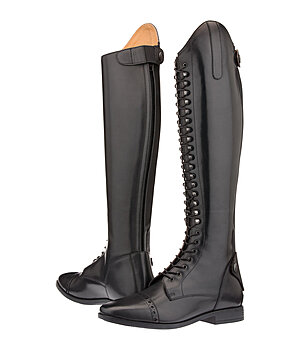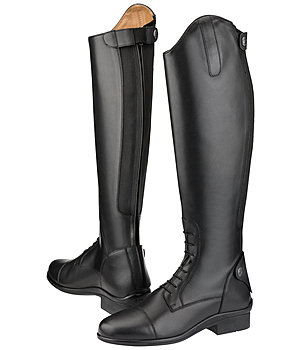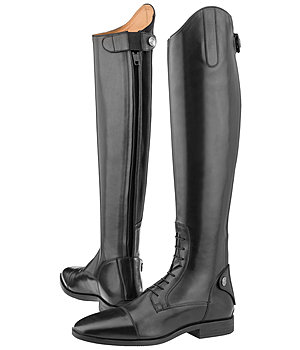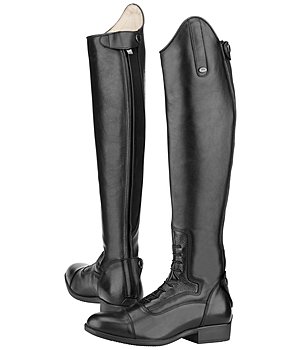Leather riding boot guide
If you ride a lot and sometimes take part in competitions, you can’t go past a pair of leather riding boots. They are comfortable, sturdy and convey the classic equestrian look. If you have decided to buy a pair of leather riding boots, you should think in advance about what requirements and needs the boots should fulfil.

Dressage or jumping boots?
When it comes to leather riding boots, a rough distinction is made between dressage boots and jumping boots. The two types of riding boots differ as follows:
Dressage riding boots
- high form
- Stiffening on the outside of the shaft
- Raised dressage arch on the shaft
- Soft inside for fine aids
- High stability in the heel area
- Zip in an inconspicuous place
Show jumping boots
- Shaft is shorter than that of the dressage boot
- Softer leather
- Elasticated calf area for more flexibility
- Lacing in the area of the groove
However, there are many models that are suitable as all-round boots for every equestrian discipline, so that you do not necessarily need a separate boot for each discipline.
SELECTED LEATHER RIDING BOOTS
Not all leather is the same
Leather is a material that is available in different qualities. The type of animal from which the leather was made plays a major role here. As a rule, full-grain cowhide is used as the outer lining for riding boots, as it is perfect for this both visually and due to its material properties. In addition to cowhide, calfskin and pigskin are also used for the inner lining because they are softer and therefore more comfortable to wear. Here is a brief overview of the advantages and disadvantages of the different types of leather.
| Cowhide | Calfskin | Pigskin |
 |  |  |
| + high comfort level | + high comfort level | + good value for money |
| + durable | + very soft | + pleasantly soft |
| + breathable | + robust | + durable |
| + medium price range | + even and fine grain | – not very breathable |
| – pronounced grain | – high price | – sensitive and prone to cracking |
| – rare raw material | – distinctive grain |
A word about the quality of leather riding boots
With leather riding boots, the quality of the leather is sometimes immediately recognisable. Very important is the condition of the animals and the further workmanship. Basically, even a non-professional can recognise a good leather quality. With our sensory organs, an assessment is easily possible:
Sight
Are there any defects or cracks in the material?
If the leather tears quickly, this is evidence of poor quality. Over time, every material suffers from wear, but with good leather there is only abrasion of the surface structure and never cracks.
Does the leather and its grain look natural?
Minor unevenness and irregularities in the grain are a sign of full-grain leather (best quality and naturalness). If the grain is absolutely even, it may be that it is artificially embossed (so-called corrected leather), which indicates the use of cheaper leather or split leather.
Is the leather coated?
When processing leather, various agents are used to make the material more resistant or to influence its appearance, e.g. impregnating agents or colour applications. If you can no longer see the natural grain because of the coating, it is safe to assume that the leather used is not of a particularly high quality and is corrected leather.
Smell
How does the leather smell?
Since the formerly common plant-based leather tanning has largely been replaced by the so-called chrome tanning, the material nowadays smells less intense. Depending on the further processing during coating or dyeing, other odour components are added. A healthy measure is crucial when it comes to odour. The leather should smell neither too strong nor too neutral and leave a pleasant impression.
Leather riding boots for tournaments
Leather riding boots are part of the basic equipment of every competition rider. However, not every leather riding boot is approved for use at tournaments.
Leather riding boots should fulfil the following criteria for certian competitons:
- Colour: dark
- Material: leather or leather-like
- Characteristics: sufficiently pronounced heel, with or without zip, elastic insert and lacing permitted
Alternative: dark ankle boots with a close-fitting boot shaft of the same colour, should correspond to the appearance of a leather riding boot.
The alternatives to long leather riding boots
Happy without leather
Consciously avoiding leather and other animal products is also becoming more and more popular among equestrians. There are now numerous non-leather alternatives to the classic leather products used in equestrian sports. Saddles, bridles, but also riding boots are available in high-quality artificial leather versions. The innovative SYLKA material is a synthetic leather that creates a high-quality look while remaining resilient and easy to care for. Synthetic leather riding boots tend to be less expensive than traditional leather riding boots, making them a great alternative for fast-growing children’s feet. They are easy to clean with a damp cloth.

Chaps and boot shanks – flexible and comfortable

In some cases, a riding boot in combination with matching chaps or boot shafts can be a better solution for the rider. Chaps and boot shafts can have the following advantages in terms of price, fit and comfort:
Price: Ankle boots and chaps or boot shafts are usually less expensive than a real leather riding boot.
Fit: For a leather riding boot, various parameters must match for an ideal fit – this is the interaction of shoe size, calf width and shaft height. If this is not the case, a pair of ankle boots and chaps or boot shafts of the right height and width can be used to cater more flexibly for „deviating“ measurements.
Comfort: The combination of ankle boots and chaps or boot shafts makes you particularly flexible as a leisure rider in the stable. After riding, you can take off the chaps or boot shafts and concentrate on stable work.












